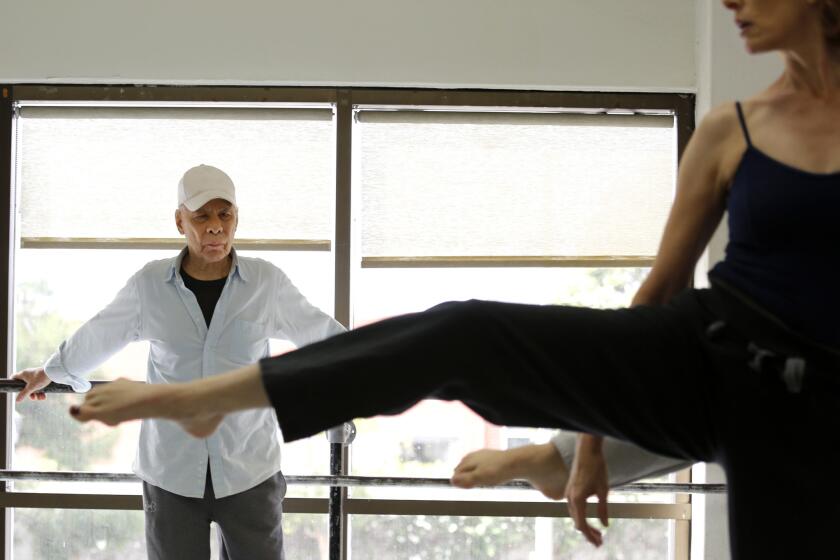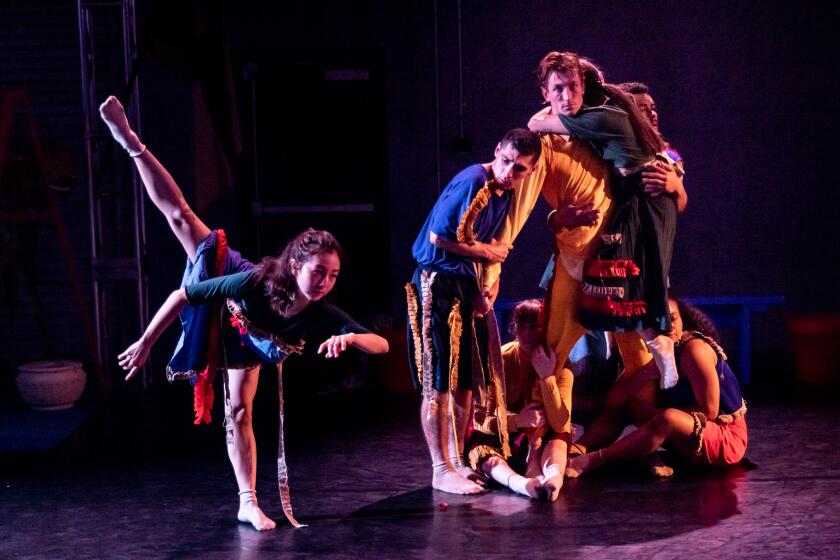Groundbreaking choreographer Rudy Perez, a trailblazer of postmodern dance, dies at age 93
Groundbreaking choreographer Rudy Perez, a pioneer of 1960s postmodern dance, died Friday, according to Sarah Swenson, a fellow choreographer, friend and member of Perezâs company.
Perez died of complications from asthma. He was 93.
Perezâs minimalist but wildly experimental work, marked by spare, precise movements, helped ignite a budding Los Angeles dance scene after he moved west from New York in the late 1970s. L.A.âs open spaces and natural landscapes inspired his innovative, site-specific works; and his interpretive abstract expressionism was so revelatory at the time, it opened up the dance landscape to new approaches.
âHe came to L.A. as a major artist, a choreographic genius known for making his own rules,â choreographer Lula Washington told The Times in 2015, adding that Perez was an influence on her. âThere was nobody here doing that type of experimentation then. He allowed other people to see the possibilities.â
Perez told The Times that his work sprang from the unconscious.
âNothing is planned,â he said in 2015. âWhen I put things together, unconsciously, it comes from my lifetime experience up to that moment. Then ultimately, it turns out to be about something for someone, certainly for me. But I donât expect for it to be the same for the audience.â
Choreographer Rudy Perez may be 85 and legally blind, but when he strolls along the sidewalks near Hollywood and Vine on a recent afternoon, his vision is crystal clear.
For the record:
11:55 a.m. Oct. 2, 2023A previous version of this story said one of Perezâs parents was a Peruvian immigrant. Both his parents were Puerto Rican.
Perez was born Nov. 24, 1929, to Puerto Rican parents, and grew up in East Harlem and the Bronx with three younger brothers. He began improvising on the dance floor at an early age, with cha-cha and the samba, at family gatherings. His father was a merchant marine who traveled frequently; his mother died of tuberculosis when he was 7, at which point he contracted the disease and spent the next three years in the hospital, mostly bedridden.
âI think a lot of the pain you see in some of my work thatâs very sort of contained comes from that experience, from being in the hospital and hardly having any visitors,â he once said. âItâs all very suppressed, but itâs there in my work.â
Perez studied with Martha Graham and Merce Cunningham in the 1950s, as well as Mary Anthony, but found his voice in New Yorkâs â60s-era, avant-garde dance scene. He was part of the experimental collective Judson Dance Theater with Yvonne Rainer, Steve Paxton, Lucinda Childs and Trisha Brown.
His first choreographed work, âTake Your Alligator With Youâ (1963), parodied magazine modeling poses. Three years later, he put together his first solo piece, âCountdown,â which featured Perez in a chair smoking a cigarette. He recalled that initially audiences werenât sure what to make of his unique form of dance. But eventually, he broke through the largely white dance establishment of the time and won over audiences.
Perez moved to L.A. in 1978 for a yearlong substitute teaching job at UCLA and formed a dance company shortly thereafter.
âIn L.A., I felt freer; I was able to go beyond,â he told The Times. âI wanted to get away from the emphasis on dance, and work more with theater and natural movement.â
Choreographers whose works were performed in Los Angeles this year share how the pandemic, as well as loss, stillness and joy, reshaped their perspective and practice.
In recent years, Perezâs vision had been severely impaired due to glaucoma and macular degeneration. He continued working every Sunday with his Rudy Perez Performance Ensemble at the Westside School of Ballet. During the early days of the COVID pandemic, several dancers in Perezâs ensemble kept the workshop going over Zoom. They have since moved it to MNR Dance Factory in Brentwood.
âRudy was so pleased that we continued the workshop,â said Anne Grimaldo, who danced in Perezâs ensemble for 35 years. âEven when his eyesight was going, [Perez] could still âseeâ like a fine-toothed comb. Heâd say, âpoint your toes.â ... He could see everything with extreme detail.â
Shortly after she graduated with her masterâs degree in dance from UCLA in 1988, Grimaldo met one of Perezâs dancers at an audition. He told her to come to his class. Grimaldo hesitated; she had heard Perez had a reputation for being tough. She eventually ended up going. âRight away he said he wanted me in the company,â Grimaldo said. âAnd I never left.â
âRudy changed all of our lives,â Grimaldo added. The workshop âwasnât just dance: It was theater, it was choreography, it was improvisation. It was up to a performance level and professional. You didnât sit down during a break and lean against the bar. When we first started out weâd always wear black. And the company was very tight. It was like a collaboration with all of us and Rudy and his direction.â
âRudy was a titan of minimalist movement,â Swenson said, âachieved by just being himself, unique in his approach and product. Fierce and demanding in the studio, he secretly had a tender heart, and Iâll miss that more than anything.â
Perez insisted his dancers take Pilates, Grimaldo added. âNow Iâm a Pilates instructor,,â she said. âI met my husband, Jeff, in the company and we have a daughter. ... I mean, everything I do and what I have is because of Rudy and my connection with him.â
Throughout his career, Perez created dozens of pieces, including work for the 1984 Olympic Arts Festival. He was also a teacher whose influence â at the USC School of Dramatic Arts and the Los Angeles County High School for the Arts, among other places â lives on in generations of choreographers and dancers.
Dance critic Lewis Segal told The Times that Perezâs vision sparked âa real firestorm in L.A.â in the late â70s. âTeaching it and choreographing [in his style], he made a difference,â Segal said. He added: âIt encouraged people to really go with their instincts, to go for broke.â
Rudy Perez brings us into a day of rehearsal in L.A., offering insight into what makes movement work.
In November 2015, UC Irvine presented Perez with a lifetime achievement award during âThe Art of Performance in Irvine: A Tribute to Rudy Perez.â Perezâs dance ensemble debuted work there that heâd choreographed for the event: the three-piece performance âSlate in Three Parts.â A month later, Colburn School restaged Perezâs 1983 piece âCheap Imitation.â
Among his many honors, Perez was awarded a National Endowment for the Arts fellowship and L.A.âs the Music Center/Bilingual Foundationâs ÂĄViva Los Artistas! Performing Arts Award. He held honorary doctorates from the Otis College of Art and Design in L.A. and the California Institute of the Arts in Valencia, and his archives are part of the USC Librariesâ Special Collections.
âIâve been very fortunate,â Perez said in 2015 of his long-running career. âIâve always been told, âGrow old gracefullyâ â and Iâm good at that. At this stage of my life, sure, itâs hard, but Iâm striving for excellence. I wanna go out with a flash.â
He is survived by his brother Richard Perez, his niece Linda Perez, and nephews Stephen and Anthony Perez, as well as his longtime friend and caregiver James Kovacs, numerous former Rudy Perez Ensemble Members, collaborators, and friends. A memorial for Perez is being planned.
Times arts editor Paula MejĂa contributed to this report.
More to Read
Start your day right
Sign up for Essential California for the L.A. Times biggest news, features and recommendations in your inbox six days a week.
You may occasionally receive promotional content from the Los Angeles Times.









